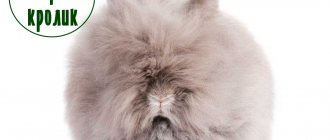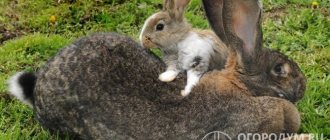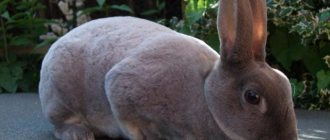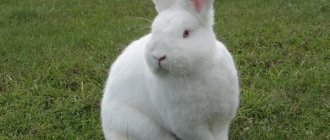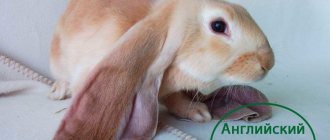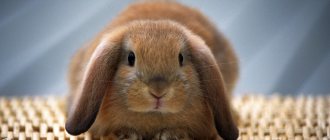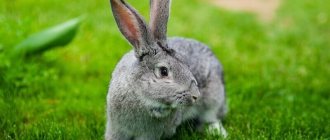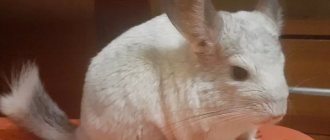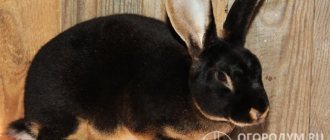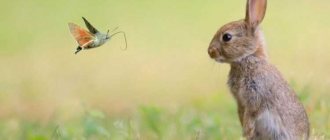When deciding to raise rabbits, novice farmers try to choose a breed that would simultaneously meet high food characteristics, be fertile, and be well adapted to breeding conditions.
The California rabbit meets all these indicators. These unpretentious large animals were bred precisely in order to learn the basics of rabbit breeding in the process of caring for them.
Origin of the breed
As the name suggests, the first representatives of the breed appeared in California.
At the beginning of the 20th century, farmer George West tried to breed meat rabbits that would differ in the quality of their fur. For these purposes, he crossed New Zealand rabbits with representatives of the ermine breed.
The result exceeded all expectations. Californians not only acquired good weight characteristics, but also gained the ability to perfectly adapt to living conditions.
Although initially the breeders were very wary of this breed, considering it a hybrid. But over time, California rabbits gained popularity among farmers around the world.
From distant California, or Three in one
The breed was born in the American state of California. Moreover, it is customary to call it a breed only now. Initially, these were real hybrids, which were developed as a result of targeted crossing of three absolutely autonomous European breeds. The genetic pool of the “Californians” was based on:
- New Zealand white rabbit;
- Russian ermine rabbit;
- Soviet chinchilla.
The result was a precocious breed with excellent meat characteristics, while they tried to breed a breed with the highest quality skin. This “breeding fiasco” unexpectedly gained popularity among breeders who were breeding rabbits for meat. By the way, the skin of the “Californian” also turned out to be of quite high quality. Therefore, about 90 years ago, the California rabbit received the status of an independent breed.
California rabbit skin
Fifty years later, from distant California, representatives of the breed set off to conquer the USSR. And it turned out that they are perfectly adapted to existence, reproduction and increase in meat mass in the conditions of the middle zone, which were not the most comfortable for their ancestors. Soviet breeders liked them so much that they began to be grown everywhere. Industrial farms, private farms - everyone in the USSR raised “Californians”. The fashion soon spread to neighboring countries. To this day, in the world, the California rabbit confidently ranks second (after the White Giant) in terms of the number of breedings among all meat breeds in the world.
Breed Features
The Californian is a large rabbit, weighing up to 5.5 kg, with a characteristic color. His body is white. The ears, paws and tail are dark. There must be a clearly defined spot of a certain size on the nose.
Interestingly, rabbits are born completely white or smoky, their spots appear after a couple of months, and their color depends on the surrounding temperature. In cold conditions the color darkens, in hot conditions it becomes lighter.
Also characteristic of the breed are: short legs, massive neck, wide chest, small head, small erect ears, red or pink eyes, and a hooked nose.
The animal's fur is short, but soft, fluffy and fluffy. The lifespan of the California rabbit is up to 10 years.
Permissible deviations from the norm
The following deviations from the California breed norm are acceptable:
- elongated neck and head;
- not entirely harmonious physique;
- the ears are set loosely and not too far apart;
- the coat is not so silky;
- pronounced chin;
- claw color.
Did you know? For culling
“
Californians
”
at exhibitions are characterized by severe weight deviations, non-red eye color, too long floppy ears, poor fur and the appearance of extra spots.
Conditions of detention
This is one of the unpretentious breeds. Californians adapt well to different climatic conditions and do not require special maintenance.
Rabbits can be raised both in cages and in specially equipped pits. The main thing is to avoid drafts and direct sunlight. The animal's home must be dry and cleaned regularly.
Optimal conditions for keeping a California rabbit:
- temperature: + 12 - +18 degrees;
- humidity 60 -70%;
- availability of ventilation.
Contents in cages
Rabbit cages should be high. So that the animal can calmly rise on its hind legs. The footage is calculated at the rate of 3 sq.m per adult, 4 sq.m per rabbit with cubs. The pallet is covered with sawdust.
Ideal cage dimensions for one rabbit: - length - 130 cm, - width - 70 cm, - height - 60 cm.
For a female with offspring (excluding queen cell): - length - 170 cm, - width - 100 cm, - height - 60 cm.
For ease of care, it is advisable to place cages next to animals of the same age.
Contents in the pit
If rabbits are bred for meat, then it is important to create conditions as close to natural as possible. For these purposes, you can equip special pits. It is important to pay attention to the condition of the soil and the level of surface water.
The arrangement of the pit must meet the following requirements:
- Minimum pit size: length - 200 cm, width - 200 cm, height - 100 cm.
- The walls are reinforced with rigid material (slate, mesh, concrete).
- The floor has a hard covering (mesh, sand, boards).
- The territory is surrounded by a fence.
- The drinking bowls are placed low.
- A mesh roof with a feeding window is being installed.
- A canopy from rain and sun is built over the feeders.
Pits are suitable for raising large numbers of animals for slaughter. However, if you are going to engage in breeding of the breed, it is better to avoid this method of keeping rabbits.
Productivity
With high-quality care for the Californian and proper fattening, the animal rapidly gains weight. At the age of two months, the baby rabbit’s weight approaches 2 kg, and at four months it approaches 3 kg. In six months, rabbits gain about 4 kg, that is, the live weight at which they are sent for slaughter. If desired, you can wait another 1 month with this procedure, then the rabbit will gain about 0.5 more kg. It makes no sense to keep animals longer than this period, since after seven months their growth slows down sharply. If we take the conversion of feed into live weight as the main guideline, then the most suitable age of rabbits for slaughter is 5 months .
Reaching a weight of 4 kg is the optimal stage at which the animal can be sent for slaughter
The slaughter yield of representatives of this breed is about 60%, of which almost 80-85% is meat. The fur quality of Californians is also rated as very high.
The fertility of females at birth is average ( 7-8 young rabbits ). Some farmers consider this a breed disadvantage, but this “minus” also has another side: a female rabbit can feed a small number of cubs without problems, therefore, the survival rate of the offspring is very high.
Californian females are wonderful mothers, capable of feeding all their offspring.
The breed does not have extremely high performance in most parameters, but it is ahead of many others in one of the most important factors - the profitability of cultivation . The specific consumption of feed per 1 kg of weight gain of an animal of a given species is practically the most economical. Of course, the weight of the Californian carcass at slaughter will be significantly less than, for example, that of the Flanders. However, such giants manage to eat a much larger amount of food per 1 kg of meat products obtained from them.
We invite you to watch a video about the rules of feeding representatives of the Californian breed, as well as how to make a feeder for rabbits with your own hands:
Caring for Californians
Despite its unpretentious living conditions, the California rabbit needs some care.
The tray should be changed daily. And every two weeks, disinfect the cage with boiling water or a 1% formaldehyde solution.
Special attention should be paid to cleaning feeders and drinking bowls. Moreover, both in a cage or pit, and in an enclosure for walking.
Organization of walking
California rabbits require free range. This has a positive effect on animal health and weight gain.
Aviary with an area of 20 square meters. m is suitable for 5 females with 30 rabbits or 25 young animals.
When arranging the territory, there are the following recommendations:
- It is advisable to choose a place for walking on a hill so that puddles do not form.
- The enclosure is fenced with a meter-long chain-link mesh with a fraction size of no more than 5 cm;
- The mesh should be dug deep. This will prevent the rabbits from digging.
- To protect from predators from above, the walking areas must also be covered with a net.
- The floor is covered with boards or concreted.
- A canopy must be provided to protect from rain and sun, under which feeders and drinking bowls are placed.
Hygiene
The basic hygiene rules of Californians include caring for fur, claws, ears, eyes, and skin.
- Rabbits' ears and eyes are examined regularly. If there is plaque or discharge, it is carefully removed using a gauze pad.
- There should be no spots, bald spots or peeling on the animal's skin.
- The claws are trimmed very carefully so as not to touch the pulp.
- The wool is periodically combed out and, if necessary, the resulting tangles are cut out.
What to feed rabbits
Although Californians are unpretentious to food, the breed is a meat breed. Therefore, special attention is paid to balanced nutrition of animals.
Adults are fed 3 times a day, young animals - 5 times.
The diet of California rabbits consists of:
- Green food (clover, dandelion, burdock, plantain, etc.). They are given to animals both fresh and dry.
- Juicy feed (vegetables, melons: cabbage, carrots, zucchini, pumpkin).
- Rough feed (straw, hay, young tree branches).
- Concentrated feed (bran, cake, legumes).
The main rule when preparing a diet is to alternate feeds wisely and do not forget about the constant presence of water in the sippy cup.
Video: California rabbit.
Features of breeding Californian rabbits
California rabbits are characterized by rapid maturation and fertility. Males are ready to mate from six months, females from five months. Moreover, for one rabbit there are from 5 to 10 female rabbits. Any season is suitable for mating. There are 4 - 5 litters per couple per year.
Principles of selection for reproduction
However, in order to get healthy offspring, several rules must be followed.
- Rabbits should not be related. Therefore, when purchasing, you should choose animals from different nests.
- Only healthy, vaccinated animals are allowed for mating.
- It is not recommended to cross the California rabbit with individuals of other breeds.
How long does pregnancy last in rabbits?
Pregnancy in a female lasts from 28 to 35 days. Its duration directly depends on the age, health status of the rabbit, and the number of cubs.
Before giving birth, the animal begins to build a nest, tearing out the hair from its abdomen, and establishing a queen cell.
The owner can help the female in improving her home. To do this, place a cardboard box or a box made of plywood in the cage.
Standard dimensions of the queen cell: length - 60 cm, width - 35 cm, height - 30 cm.
Fostering and caring for young animals
In one litter, a female rabbit gives birth to 8 to 12 babies. Moreover, the female has enough milk to feed them all. Rabbits are born blind, weighing about 45 grams.
The number of babies at feeding can be controlled. Breeders have a practice when rabbits from one female are passed on to another. At the same time, female rabbits accept their “adoptees” well.
From 14 days, complementary foods begin to be introduced into the diet of young animals. 45 days after birth, the female is separated from her offspring. And so that babies get used to adult food faster, chamomile and St. John's wort are added to the food, and vitamin B is added to the water.
About the description
When talking about describing such a breed, first of all you need to talk about its very interesting color. The animals are white, but their ears are either black or dark brown, their paws and tail are also the same color, and there is a spot on their nose. As for the eyes, they are red. This is the external characteristic. Appearance also differs by month, especially with regard to the characteristic spotted colors.
If we talk about the shape of the body, then it fits the generally accepted breed standards for producing a large amount of meat. The head of such animals is not large, the ears reach up to 11 cm, they stand straight, and the nose has a hump. The body is strongly built, quite large, the neck is short. The most meaty area is considered to be the lower back, as well as the sacrum, the legs do not differ in length, and there is no dewlap.
Such animals are well built and have strong bones, but the bones are light but strong. A wide chest and well-developed muscles make this breed very attractive in appearance. The Californian rabbit is a truly beautiful animal, so the cute Californian rabbits, whose breeding is becoming more and more intensive, often become pets; children of the Californian breed are very fond of rabbits.
As for the fur, it is thick and of excellent quality. Due to their universal color, the fur of such animals is of great interest for leather and fur production. It should be noted that this breed is very similar in appearance to another “butterfly” breed, however, despite the strong external similarity, there are also differences, which consist in the fact that “butterflies” have butterfly-shaped spots on their noses.
When baby rabbits are born, they are most often white, but the color can also be smoky. Moreover, at birth, characteristic spots are not observed, but you should not be afraid of this, since they appear later. It must be said that if the air temperature is high, then the color of the skin becomes lighter, and, accordingly, when the temperature drops, the color darkens.
If you keep such animals for your own needs or simply to get meat, you can ignore some of the shortcomings. However, if they are bred as breeding animals, or there is a goal of taking part in exhibitions, then the exterior should not have any flaws, since because of them the animal may be rejected:
- the animal weighs more than 5.5 or less than 3.5 kilograms;
- the ears are too long or they droop;
- the spot on the nose is too large and fits right into the eyes;
- there are dark spots that are unnecessary;
- low quality fur, that is, it may be too rare or not elastic;
- the eyes are not red, but some other shade.
Productive qualities
One of the important indicators for breeding is the breed productivity index. For Californians it is 65%.
The main criteria are:
- rapid weight gain (a two-month-old rabbit already weighs 2.5 kg);
- ratio of meat (80%) to fat (2.5%);
- fertility (up to 15 rabbits per litter);
- rapid recovery of the female (a female rabbit can give birth to up to 35 cubs in a year).
All these characteristics make California rabbits one of the most profitable breeds for industrial breeding.
Appearance
The body size and shape meet the standard requirements for meat animals. The compact body has a torpedo-shaped shape. The correct physique has some bias in the direction of a strong constitution. This does not happen due to the bones - light and thin. Massiveness is ensured by well-developed body muscles.
The relatively small head has short ears that always stand upright. They are rounded at the ends. The short neck smoothly transitions into a massive body. The main share of meat is provided by developed muscles located in the lumbosacral region. The paws of the California rabbit are thick and strong, well furred.
The average weight of an adult is 4.5 kg. Length – 54-55 cm. The short body is developed proportionally. The back has a rounded shape. Eyes range from pink to ruby. There are white antennae on the muzzle. The tail is short, set close to the body. The claws are black or brown. The body is covered with thick dense fur.
The main feature of the Californian rabbit is its color, which allows you to immediately distinguish it from animals of other breeds. The main part of the body is covered with thick snow-white fur. The exception is the area of the nose and ears on the muzzle, as well as the tail and paws. They are dark brown or completely black in color. The spots are clearly defined. There is no excess pigmentation. California rabbits look beautiful.
How to choose a Californian rabbit breed
It should be noted that you should buy a Californian at an early age, since mature individuals are very timid and can endure moving painfully and even die.
Nuances when choosing
It is best to purchase a Californian from a nursery or specialized farm.
When purchasing, you need to carefully examine the animal, paying attention to: - compliance with the breed standard (color, body proportions, weight, length and position of the ears); - external signs of a healthy animal (clean eyes, ears, shiny coat, good appetite); — behavioral characteristics (the baby must be mobile, active, inquisitive); — the health status of the baby rabbit’s parents; - high-quality living conditions (cleanliness of the cage, balanced diet, well-established drinking regime).
When relocating, it is advisable to create conditions for the animal as close as possible to the nursery. In this case, adaptation will be more gentle. The baby rabbit completely gets used to the new living conditions in one month.
Video: The California rabbit is not so much fur.
Advantages and disadvantages
The undoubted advantages include:
- early maturity and milk production of females;
- high productivity;
- genetic stability of the breed;
- good adaptability to living conditions;
- unpretentiousness in feeding;
- survivability of young animals.
The disadvantages can be considered that:
- representatives of this breed are not able to show significant weight gain during fattening;
- due to a weak skeleton, animals are not very adapted to life in a pit;
- Californians are not giants, therefore, they are inferior in weight to rabbits of other breeds.
Feeding
To have a healthy and productive livestock, it is necessary to provide the animals with complete and rational food. What to feed Californian breed rabbits on a home farm; are there any differences in the diet at different times of the year?
For rapid growth, representatives of this breed should be provided with food rich in protein. Whenever possible, include meat or fish meal, dairy products and other protein supplements in their diet. Animals must have constant access to water. In winter, it is better to provide the animals with warm liquid.
Otherwise, the feeding process is similar to normal. The diet is made up of hay, root vegetables, feed, twigs and green additives. In the summer, grass feed is introduced, preferably rich in protein.
What can you feed?
Depending on the season, the cost of feeding Californian rabbits can be easily minimized, since they do not have to buy expensive special food; they can get by with affordable products.
The diet should include:
- Green food. This includes meadow, field, forest and garden herbs, you can make assorted herbs using burdock, tansy, dandelion, clover, wormwood, plantain, sainfoin. Grass cut from the lawn will also work well, just make sure it is dry. It is fundamentally important when feeding rabbits that the animals have free access to clean and fresh water. In winter you need to make sure it is warm.
- Vegetables. The menu includes pumpkin, rutabaga, zucchini, cabbage, and carrots.
- Escape. You can give rabbits leaves and branches of maple, ash, linden, birch, aspen, bean tops, and peas.
- Cereals and beans. Oats, soybeans, corn, and peas are suitable.
- Delicacies. They are included occasionally and in small quantities, no more than 2% of the total daily intake. Such products include apple, kohlrabi, banana, broccoli, parsley.
- Other components. To ensure proper nutrition with the required amount of vitamins and minerals, be sure to include meat and bones, fish meal, and bran in the rabbits’ diet.
What not to feed rabbits!
- Dairy products. Despite the fact that these animals need an optimal amount of protein, dairy products such as cottage cheese, milk, whey, etc. are highly undesirable to include in their diet. It is better if the proteins are of plant origin.
- Vegetables. This is not a contradiction to feeding rules. The bottom line is that vegetables should be present in the diet of rabbits, but some types are absolutely not suitable, and you need to be aware of them. So, you should not give your rabbits cucumbers, onions, red cabbage, tomatoes, new potatoes, beets and eggplants.
- Fruits. The products listed above can be included, but in this case it is better to avoid exotic foods; avocados and mangoes are not for rabbits.
- Cereals. The situation is the same as with vegetables and fruits. There are some grains that are absolutely not suitable for feeding Californian rabbits: rye, millet, rice and millet. Red and black legumes and young peas are also not suitable.
- Poisonous herbs. When mowing the grass yourself, check the lawn in advance to ensure that celandine, hemlock, wild radish, horsetail, as well as dream grass, poppy, and buttercup do not grow on it. Even one blade of these plants among an armful of grass can lead to the death of rabbits.
- Any baked goods. Here we mean not only sweet cookies, cakes, gingerbreads, but even ordinary white yeast bread.
Vaccinations for rabbits
Animals can be vaccinated at veterinary clinics or independently. The main thing is to monitor the quality and storage rules of drugs, as well as strictly follow the vaccination schedule.
- On the 28th day, vaccination against myxomatosis.
- On the 45th day - from rabbit viral hemorrhagic disease (RVHD).
- At 3 months - prevention of coccidiosis.
- At 4 months (and then every 6 months) - revaccination of myxomatosis.
- At 5 months (and then every 6 months) - revaccination with VGBV.
Diseases, vaccination, prevention
This breed is characterized by all the diseases inherent in rabbits.
Hemorrhagic disease virus
The disease is transmitted through the excrement of animals that have suffered from VHD, as well as through direct contact of healthy and sick individuals, equipment and clothing of people caring for animals.
The virus persists in the skins of slaughtered sick animals for up to 3 months.
The mortality rate from this disease is one hundred percent and rapid. Only regular vaccination can save livestock. It is carried out on days 45 and 105 from the birth of young animals, then once every six months.
Myxomatosis
It is transmitted through the bites of blood-sucking insects and through contact with sick individuals. From one to two thirds of the livestock dies when the disease occurs, and all recovered animals are carriers of the virus.
If the outbreak of infection could not be prevented, then all animals without exception must be slaughtered.
Young animals are vaccinated at different times, depending on the type of vaccine. For example, a monovalent vaccination is given once on the 30th day of a baby rabbit’s life.
Read more in the article about myxomatosis in rabbits.
Other diseases
Pasteurellosis is often found on rabbit farms, which can also be eliminated with timely vaccination in the region. But there are no vaccinations against coccidosis; it is caused by parasites, infection with which most often occurs due to poor nutrition and poor care.
Non-infectious diseases that are also dangerous for livestock are bloating. If this is not a symptom of coccidosis, then it is the result of fermentation from poor nutrition. The young can die within a few hours. Prevention of the disease is by feeding hay and granulated feed.
